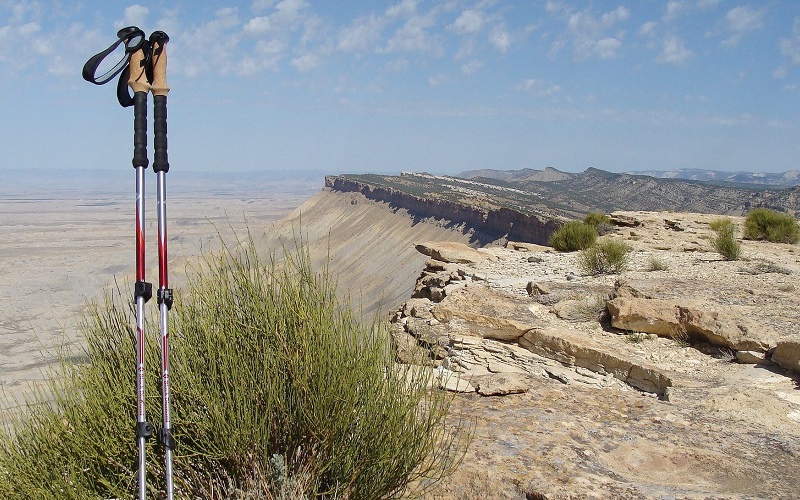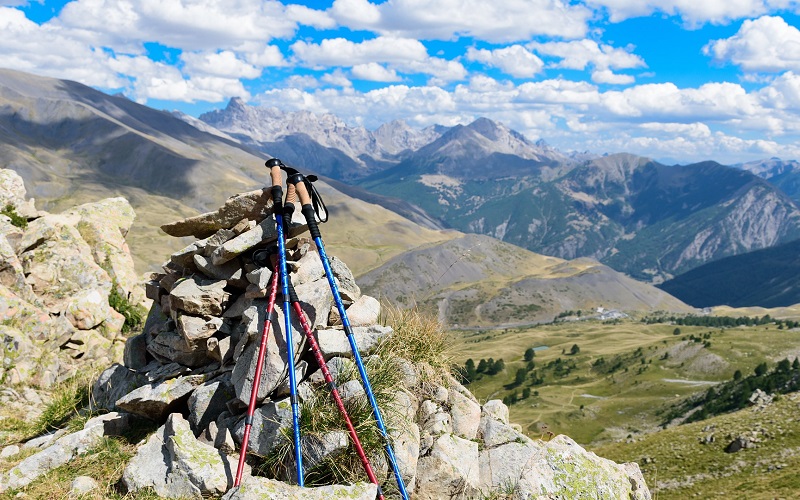Hiking poles or trekking poles are standard hiking equipment that is used by many hikers, backpackers, walkers, trekkers, and snowshoers.
The reason why people choose hiking with poles is quite simple, using hiking poles provides stability and support on any type of terrain that you are going through.
Using hiking poles does not decrease the amount of energy that you use during your hike as the poles require you to use your arms more than when you are walking without them.
However, hiking poles will distribute the amount of energy that you use during your hike in a way that can improve your overall endurance.
Types Of Trekking Poles

There are two main types of hiking poles. Trekking poles are sold in pairs and will be used in tandem.
They enhance stability and can reduce the force placed on your knees when backpacking and hiking.
Most trekking poles will have an adjustable length.
Some of these poles will have internal springs that will absorb shock to help reduce impact further.
A hiking staff is a single pole that will be most effective when hiking on flat terrain with little on your back.
A hiking staff is typically adjustable, and some have shock-absorbing features.
Some even have a camera mount built in under the handle, so you can use it as a monopod.
Hiking Pole Features

There are several features to consider when searching for a good set of hiking poles to use. These include:
- Adjustable: Many hiking poles will have a length that is adjustable in order to enhance their stability on different terrains. The average adjustable height is anywhere from 24 to 55 inches. Typically, you will shorten the poles as you go up a hill and lengthen them when you are going down a hill.
- Shock Absorption: These hiking poles have internal springs that will absorb shock while you are walking down a hill. With many of these poles, you can turn off this feature when you do not need it, such as when you are going up a hill. If you have damaged or weak hips, knees, or ankles, a shock-absorbing pole can be helpful.
- Standard Hiking Poles: these will be lighter, less expensive, and do not have a shock-absorbing feature. While they do not absorb as much impact, they will provide the balance and support you need.
- Ultralight: these poles are easy to pack and typically weigh less than a pound combined.
- Camera mount: As mentioned, some hiking poles will have a built-in camera mount that will allow the pole to be used as a monopod for your camera.
Locking Mechanisms
Hiking poles can be identified by their interlocking sections that allow the length to be adjusted.
These sections allow you to adjust the length for your height as well as the terrain that you are on.
A locking mechanism will be used to secure the poles at the desired length.
There are four main types of locking mechanisms that are typically used with hiking poles.
- Push-button locks: a hiking pole that uses this type of locking mechanism will snap into place and lock with one pull. To release the lock, you will push the button.
- External lever locks: a clamp-like mechanism is used for these locks. It is like a lever and is easy and fast to adjust, even when you are wearing gloves.
- Twist locks: this type of lock uses a screw and expander set-up that is durable and strong.
- Combination locks: some hiking poles will use a combination of locks. For example, the top may have a twist lock, and the bottom may use a lever lock.
Shaft Materials For Hiking Poles
The makeup of the shaft is important in determining the overall weight of the hiking pole. Some common materials that are used for the shaft include:
- Aluminium: aluminium is both economical and durable. Hiking poles made with this material are typically lightweight. The price will depend on the gauge of the aluminium that is used. While aluminium may bend under high stress, it will not likely break.
- Carbon Fibre Hiking Poles: this is a more expensive but lighter option. These poles weigh about 13 to 18 ounces per pair. They help reduce vibrations, but when under high amounts of stress, they can break or splinter.
Grip Material For Hiking Poles
The grip material is another important consideration. Common materials that are used for hiking pole grips include:
- Cork will conform to the shape of your hand, decrease vibrations, and resist moisture from your hands.
- Foam is the softest to touch and absorbs moisture from sweaty palms.
- Rubber insulates the hands from the cold, shocks, and vibrations. It is the best choice in cold-weather hiking situations. It is more likely to cause blisters or sweaty hands, which means it is not ideal for hiking in warmer weather.
Hiking Poles For Women

There are hiking poles that are specifically designed for women. These are typically a bit shorter and will have grips that are smaller than those found on a unisex pole.
This makes the poles better suited for those who have smaller hands. In addition, they are easier to swing because they have a lighter weight.
Conclusion
When it comes to choosing the best hiking poles, you should consider the materials that the shaft is made of and the grip.
You may want to choose hiking poles that have additional features, such as a camera mount.
Some other things that you may come across when searching for the best hiking poles are wrist straps. These help keep the poles attached to your wrists and make them easier to carry.
You should also consider the material that the tip is made from. Steel or carbide tips are often used in order to provide traction.
A rubber tip protector can help lengthen the life of your hiking gear when stowing your poles in your pack.
Resources:



